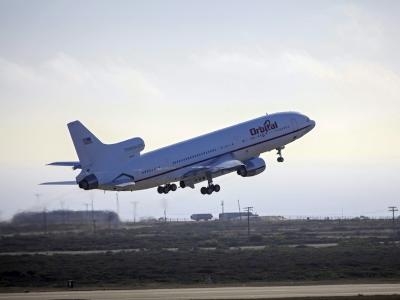Sat, Jun 29, 2013
IRIS Spacecraft Launched From Orbital Sciences Corp Aircraft
NASA's Interface Region Imaging Spectrograph (IRIS) spacecraft launched Thursday at 1927 PDT from Vandenberg Air Force Base, CA. The mission to study the solar atmosphere was placed in orbit by an Orbital Sciences Corporation Pegasus XL rocket. "We are thrilled to add IRIS to the suite of NASA missions studying the sun," said John Grunsfeld, NASA's associate administrator for science in Washington. "IRIS will help scientists understand the mysterious and energetic interface between the surface and corona of the sun."

IRIS is a NASA Explorer Mission to observe how solar material moves, gathers energy and heats up as it travels through a little-understood region in the sun's lower atmosphere. This interface region between the sun's photosphere and corona powers its dynamic million-degree atmosphere and drives the solar wind. The interface region also is where most of the sun's ultraviolet emission is generated. These emissions impact the near-Earth space environment and Earth's climate.
The Pegasus XL carrying IRIS was deployed from an Orbital L-1011 carrier aircraft over the Pacific Ocean at an altitude of 39,000 feet, off the central coast of California about 100 miles northwest of Vandenberg. The rocket placed IRIS into a sun-synchronous polar orbit that will allow it to make almost continuous solar observations during its two-year mission.
The L-1011 took off from Vandenberg at 1830 PDT and flew to the drop point over the Pacific Ocean, where the aircraft released the Pegasus XL from beneath its belly. The first stage ignited five seconds later to carry IRIS into space. IRIS successfully separated from the third stage of the Pegasus rocket 1940. At 2005 PDT, the IRIS team confirmed the spacecraft had successfully deployed its solar arrays, has power and has acquired the sun, indications that all systems are operating as expected.
"Congratulations to the entire team on the successful development and deployment of the IRIS mission," said IRIS project manager Gary Kushner of the Lockheed Martin Solar and Atmospheric Laboratory in Palo Alto, Calif. "Now that IRIS is in orbit, we can begin our 30-day engineering checkout followed by a 30-day science checkout and calibration period."
IRIS is expected to start science observations upon completion of its 60-day commissioning phase. During this phase the team will check image quality and perform calibrations and other tests to ensure a successful mission.
(Image provided by NASA)
More News
From 2021: The Inside Skinny On What Being An ANN Oshkosh Stringer Is All About By ANN Senior Stringer Extraordinare, Gene Yarbrough The annual gathering at Oshkosh is a right of p>[...]
Video Showed That During The Takeoff, The Nose Baggage Door Was Open On May 10, 2025, about 0935 eastern daylight time, a Piper PA-32RT-300, N30689, was destroyed when it was invol>[...]
Get The Latest in Aviation News NOW on Instagram Are you on Instagram yet? It's been around for a few years, quietly picking up traction mostly thanks to everybody's new obsession >[...]
"I think what is key, we have offered a bonus to air traffic controllers who are eligible to retire. We are going to pay them a 20% bonus on their salary to stay longer. Don't reti>[...]
Aero Linx: Pilot Briefing The gathering, translation, interpretation, and summarization of weather and aeronautical information into a form usable by the pilot or flight supervisor>[...]
 Oshkosh Memories: An Aero-News Stringer Perspective
Oshkosh Memories: An Aero-News Stringer Perspective NTSB Prelim: Piper PA32RT
NTSB Prelim: Piper PA32RT ANN FAQ: Follow Us On Instagram!
ANN FAQ: Follow Us On Instagram! Aero-News: Quote of the Day (05.28.25)
Aero-News: Quote of the Day (05.28.25) ANN's Daily Aero-Term (05.28.25): Pilot Briefing
ANN's Daily Aero-Term (05.28.25): Pilot Briefing



